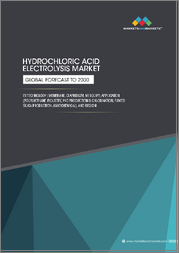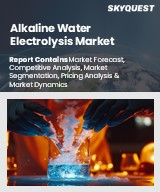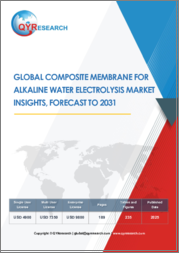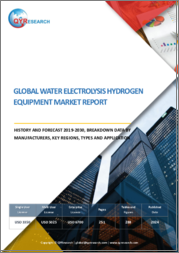
|
시장보고서
상품코드
1797984
세계의 알칼리 수전해 시장 : 예측 - 제품 유형별, 유량별, 용량별, 용도별, 최종 사용자별, 지역별 분석(-2032년)Alkaline Water Electrolysis Market Forecasts to 2032 - Global Analysis By Product Type, Flow Rate, Capacity, Application, End User and By Geography |
||||||
Stratistics MRC에 따르면 세계의 알칼리 수전해 시장은 2025년에 2,421억 달러로 추정되고, 2032년까지는 8,878억 달러에 이를 것으로 예측되며, 예측 기간 중 CAGR 20.4%로 성장할 전망입니다.
알칼리 수전해는 알칼리성 전해질(일반적으로 수산화칼륨(KOH))을 사용하여 물을 수소와 산소로 분해하고 수소를 생산하기 위한 확립된 전기화학 공정입니다. 상대적으로 낮은 온도 및 압력에서 작동하며 비용 효과, 내구성 및 산업용 용도 분야에서의 확장성으로부터 선호됩니다. 이 방법은 두 개의 전극과 격막을 이용하여 가스를 분리하기 때문에 대규모 수소 생성에 적합합니다.
전력 분야에서 클린 수소 수요 증가
발전 및 수송 분야에서 클린 수소 수요 증가가 알칼리 수전해 시장을 크게 견인하고 있습니다. 각국이 에너지 믹스의 탈탄소화에 종사하는 동안 수소는 신재생 에너지의 저장 및 연료전지 용도의 연료로서 중요한 벡터로 부상하고 있습니다. 알칼리 시스템은 수소를 대량 생산하기 위한 비용 효율적이고 신뢰할 수 있는 솔루션을 제공합니다. 업계에서 수년간의 실적이 신뢰를 높이고 기후 변화 목표 달성을 목표로 하는 전력회사와 정부에게 선호되는 선택이 되었습니다.
높은 전력 요구 사항
알칼리 수전해 시스템의 높은 전력 요구 사항은 특히 고가의 전력 및 탄소 집약적인 전력을 사용하는 지역에서 여전히 큰 과제가 되고 있습니다. 이 프로세스는 입증되고 안정적이지만 에너지 소비가 높기 때문에 저비용 신재생 전력과 결합하지 않는 한 수익성이 제한됩니다. 또한, 송전망에 대한 의존은 유연성을 방해하고 운전 비용을 증가시킵니다. 이 제약은 특히 고체 산화물 전해조 및 양성자 교환막(PEM) 시스템과 같은 보다 효율적이고 선진적인 전해 기술과 비교할 때 업계를 조심스럽게 합니다.
신재생 에너지 통합 확대
신재생 에너지 통합의 확대는 알칼리 수전해 도입의 큰 기회가 됩니다. 풍력발전 및 태양광 발전의 설비 용량이 세계적으로 확대됨에 따라 잉여 신재생 전력을 알칼리 시스템에 의한 그린 수소 제조에 효율적으로 이용할 수 있게 됩니다. 오프 그리드 전원 및 하이브리드 전원과의 호환성은 원격지 및 분산 용도의 매력을 향상시킵니다. 신재생 에너지와 전해의 융합은 억제를 완화하고, 에너지 저장을 개선하며, 특히 넷 제로 목표로 이행하고 있는 시장에서 국가의 수소 전략을 지원합니다.
변동하는 재생에너지 공급
변동하는 재생에너지 공급은 알칼리 수전해 시스템의 성능과 경제성에 중요한 위협을 초래합니다. PEM 전해조와 달리 알칼리 시스템은 간헐적인 전력을 효율적으로 처리하는 데 필요한 동적 응답 능력이 부족합니다. 이 때문에 태양광이나 풍력의 변동 입력에 대해서 최적으로 운전하는 능력이 제한됩니다. 전력 입력이 일정하지 않은 것은 부품의 수명이나 수소 순도에도 영향을 미칠 수 있어, 유지 보수 비용 증가 및 운전 효율의 저하를 초래할 가능성이 있기 때문에 재생에너지가 풍부한 지역에 따라서는 채용이 보급될 수도 있습니다.
COVID-19의 영향 :
COVID-19 팬데믹은 당초 세계 공급망을 혼란시켜 알칼리 수전해 시장 전체의 장비 납품과 프로젝트 실시를 지연시켰습니다. 그러나 팬데믹 후 녹색 인프라에 중점을 둔 부흥 계획은 수소 기술에 대한 투자를 재개했습니다. 각국 정부는 경기자극책을 청정에너지로 돌려 수소의 파일럿 프로젝트와 장기적인 이니셔티브를 가속시켰습니다. 위기는 또한 에너지 회복력의 필요성을 부각시켜 분산형 수소 발전에 대한 관심을 더욱 높였습니다. 그 결과 단기적인 영향은 부정적이었지만 장기적인 전망은 크게 개선되었습니다.
예측 기간 중 고체 알칼리 수전해조 분야가 최대가 될 전망
고체 알칼리 수전해조 부문은 비용 효율성, 스케일업 용이성 및 운영 안정성으로 인해 예측 기간 동안 최대 시장 점유율을 차지할 것으로 예측됩니다. 이 시스템은 순도와 장기 내구성이 필수적인 산업 규모의 수소 제조에 널리 채택되었습니다. 입증된 실적 및 저비용 알칼리 용액으로 수소 선진국에서도 신흥 경제 국가에서도 유리한 선택이 되고 있습니다. 지속적인 기술 개선으로 PEM 대체품에 대한 경쟁력도 높아지고 있습니다.
예측 기간 동안 10m3/h 미만의 부문이 가장 높은 CAGR을 나타낼 것으로 예측됩니다.
예측 기간 동안 10m3/h 미만의 부문은 연구, 조종사 및 소규모 산업 환경에서 소형 모듈형 전해조 수요 증가로 인해 가장 높은 성장률을 보일 것으로 예측됩니다. 이러한 저용량 유닛은 수소 용도 테스트, 교육 용도 또는 분산형 셋업에서 태양광 발전 시스템과의 통합에 이상적입니다. 합리적인 가격, 최소한의 공간 요건, 원격지에서의 전개에 적합하기 때문에 수소의 초기 단계에서의 전개에 중점을 둔 선진 경제 국가와 신흥 경제 국가 모두에서 매력적인 제품이 되고 있습니다.
최대 점유율을 차지하는 지역 :
예측 기간 동안 아시아태평양이 가장 큰 시장 점유율을 차지할 것으로 예측됩니다. 이는 정부의 강력한 이니셔티브, 대규모 신재생 에너지 설비, 중국, 일본, 한국 등 국가에서의 산업용 수소 소비량 증가로 인한 것입니다. 지원 규제 틀과 관민 파트너십이 국내 수소 생산 능력을 가속화하고 있습니다. 게다가 이 지역의 탄소 배출 감축 노력 및 대규모 인프라 프로젝트는 아시아태평양을 세계의 그린 수소 투자 허브로 자리잡고 있습니다.
CAGR이 가장 높은 지역 :
예측 기간 동안 북미가 가장 높은 CAGR을 나타낼 것으로 예측됩니다. 이는 연방 정부의 자금 증가, 탈탄소화 목표, 미국과 캐나다의 대규모 클린 수소 프로젝트가 원동력이 되고 있습니다. 주요 기업은 전해조 제조 및 전개에 투자하고 있으며, 인플레이션 감소법 및 기타 청정 에너지 관련법은 큰 인센티브를 제공합니다. 운수 및 산업 부문에서의 수요 증가에 따라 북미는 그린 수소 밸류 체인에서 경쟁력 있는 기업로서 급속히 대두하고 있습니다.
무료 맞춤형 서비스
이 보고서를 구독하는 고객은 다음 무료 맞춤설정 옵션 중 하나를 사용할 수 있습니다.
- 기업 프로파일
- 추가 시장 기업의 종합적 프로파일링(3개사까지)
- 주요 기업의 SWOT 분석(3개사까지)
- 지역 세분화
- 고객의 관심에 응한 주요국 시장 추계, 예측 및 CAGR(주 : 타당성 확인에 따름)
- 경쟁 벤치마킹
- 제품 포트폴리오, 지리적 존재, 전략적 제휴에 기반한 주요 기업 벤치마킹
목차
제1장 주요 요약
제2장 서문
- 개요
- 이해관계자
- 조사 범위
- 조사 방법
- 데이터 마이닝
- 데이터 분석
- 데이터 검증
- 조사 접근
- 조사 자료
- 1차 조사 자료
- 2차 조사 자료
- 전제조건
제3장 시장 동향 분석
- 성장 촉진요인
- 성장 억제요인
- 기회
- 위협
- 제품 분석
- 용도 분석
- 최종 사용자 분석
- 신흥 시장
- COVID-19의 영향
제4장 Porter's Five Forces 분석
- 공급기업의 협상력
- 구매자의 협상력
- 대체품의 위협
- 신규 참가업체의 위협
- 경쟁 기업간 경쟁 관계
제5장 세계의 알칼리 수전해 시장 : 제품 유형별
- 고체 알칼리 수전해 장치
- 음이온 교환막 알칼리 수전해 장치
- 액체 알칼리 수전해 장치
제6장 세계의 알칼리 수전해 시장 : 유량별
- 10 m3/h 미만
- 10-30 m3/h
- 30-60 m3/h
- 60-80 m3/h
- 80 m3/h 이상
제7장 세계의 알칼리 수전해 시장 : 용량별
- 1MW 미만
- 1-5MW
- 5-20MW
- 20MW 이상
제8장 세계의 알칼리 수전해 시장 : 용도별
- 발전소
- 제철소
- 일렉트로닉스 및 태양광 발전
- 산업 가스
- 기타 용도
제9장 세계의 알칼리 수전해 시장 : 최종 사용자별
- 에너지 기업
- 화학회사
- 산업가스회사
- 정부기관
- 운수회사
제10장 세계의 알칼리 수전해 시장 : 지역별
- 북미
- 미국
- 캐나다
- 멕시코
- 유럽
- 독일
- 영국
- 이탈리아
- 프랑스
- 스페인
- 기타 유럽
- 아시아태평양
- 일본
- 중국
- 인도
- 호주
- 뉴질랜드
- 한국
- 기타 아시아태평양
- 남미
- 아르헨티나
- 브라질
- 칠레
- 기타 남미
- 중동 및 아프리카
- 사우디아라비아
- 아랍에미리트(UAE)
- 카타르
- 남아프리카
- 기타 중동 및 아프리카
제11장 주요 발전
- 계약, 파트너십, 협업 및 합작투자
- 인수 및 합병
- 신제품 발매
- 사업 확대
- 기타 주요 전략
제12장 기업 프로파일링
- Nel Hydrogen
- Asahi Kasei
- Green Hydrogen.dk
- ShaanXi HuaQin
- Next Hydrogen Corp.
- Hydrogenics
- Thyssenkrupp
- Teledyne Energy Systems, Inc.
- McPhy Energy SA
- Siemens Energy AG
- ITM Power PLC
- Plug Power Inc.
- John Cockerill Group
- Enapter AG
- Bloom Energy Corp.
- Proton Motor Power Systems PLC
- Fusion Fuel Green PLC
- Ohmium International
According to Stratistics MRC, the Global Alkaline Water Electrolysis Market is accounted for $242.1 billion in 2025 and is expected to reach $887.8billion by 2032 growing at a CAGR of 20.4% during the forecast period. Alkaline Water Electrolysis is a well-established electrochemical process used to produce hydrogen by splitting water into hydrogen and oxygen using an alkaline electrolyte, typically potassium hydroxide (KOH). Operating at relatively low temperatures and pressures, it is favored for its cost-effectiveness, durability, and scalability in industrial applications. This method utilizes two electrodes and a diaphragm to separate gases, making it suitable for large-scale hydrogen generation.
Market Dynamics:
Driver:
Rising demand for clean hydrogen in power
Rising demand for clean hydrogen in power generation and transportation sectors is significantly driving the alkaline water electrolysis market. As nations strive to decarbonize their energy mix, hydrogen emerges as a key vector for storing renewable energy and fueling fuel cell applications. Alkaline systems offer a cost-effective and reliable solution for mass hydrogen production. Their long-standing presence in the industry further enhances trust, making them a preferred choice for utilities and governments aiming to meet climate goals.
Restraint:
High power requirement
The high power requirement of alkaline water electrolysis systems remains a major challenge, especially in regions with expensive or carbon-intensive electricity. Although the process is proven and stable, its energy consumption rate limits profitability unless paired with low-cost renewable power. Additionally, grid dependency can hinder flexibility and raise operational costs. This constraint has made industries cautious, particularly when comparing with more efficient or advanced electrolysis technologies like Proton Exchange Membrane (PEM) systems or Solid Oxide Electrolyzers.
Opportunity:
Expansion in renewable energy integration
The expansion in renewable energy integration offers a robust opportunity for alkaline water electrolysis adoption. As wind and solar capacity scales globally, surplus renewable electricity can be efficiently utilized for green hydrogen production through alkaline systems. Their compatibility with off-grid or hybrid power sources enhances their attractiveness for remote or decentralized applications. This convergence of renewables and electrolysis helps mitigate curtailment, improves energy storage, and supports national hydrogen strategies, especially in markets transitioning toward net-zero targets.
Threat:
Fluctuating renewable energy supply
Fluctuating renewable energy supply poses a key threat to the performance and economics of alkaline water electrolysis systems. Unlike PEM electrolyzers, alkaline systems lack the dynamic response capability required to efficiently handle intermittent power. This limits their ability to run optimally with variable solar or wind inputs. Inconsistent electricity input may also affect component life and hydrogen purity, potentially increasing maintenance costs and reducing operational efficiency, thereby discouraging adoption in certain renewable-rich regions.
Covid-19 Impact:
The COVID-19 pandemic initially disrupted global supply chains, delaying equipment deliveries and project implementations across the alkaline water electrolysis market. However, post-pandemic recovery plans emphasizing green infrastructure led to renewed investments in hydrogen technology. Governments channeled stimulus packages toward clean energy, accelerating hydrogen pilot projects and long-term initiatives. The crisis also highlighted the need for energy resilience, further pushing interest in decentralized hydrogen generation. Consequently, while short-term impacts were negative, the long-term outlook improved substantially.
The solid alkaline water electrolyzers segment is expected to be the largest during the forecast period
The solid alkaline water electrolyzers segment is expected to account for the largest market share during the forecast period propelled by, its cost-efficiency, ease of scale-up, and operational stability. These systems are widely adopted in industrial-scale hydrogen production where purity and long-term durability are essential. Their proven track record and low-cost alkaline solution make them a favorable choice in both developed and emerging hydrogen economies. Continued technological refinements are also enhancing their competitiveness against PEM alternatives.
The less than 10 m3/h segment is expected to have the highest CAGR during the forecast period
Over the forecast period, the less than 10 m3/h segment is predicted to witness the highest growth rate influenced by, increasing demand for compact and modular electrolyzers in research, pilot, and small-scale industrial settings. These low-capacity units are ideal for testing hydrogen applications, educational use, or integrating with solar PV systems in decentralized setups. Their affordability, minimal space requirement, and suitability for remote deployments make them attractive in both developed and emerging economies focusing on early-stage hydrogen deployment.
Region with largest share:
During the forecast period, the Asia Pacific region is expected to hold the largest market share, fuelled by strong government initiatives, massive renewable energy installations, and rising industrial hydrogen consumption in countries like China, Japan, and South Korea. Supportive regulatory frameworks and public-private partnerships are accelerating domestic hydrogen production capacities. Moreover, the region's commitment to reducing carbon emissions, coupled with large-scale infrastructure projects, is positioning Asia Pacific as a global hub for green hydrogen investments.
Region with highest CAGR:
Over the forecast period, the North America region is anticipated to exhibit the highest CAGR, driven by increased federal funding, decarbonization goals, and major clean hydrogen projects across the U.S. and Canada. Key players are investing in electrolyzer manufacturing and deployment, while the Inflation Reduction Act and other clean energy legislation offer significant incentives. With growing demand from the transportation and industrial sectors, North America is rapidly emerging as a competitive player in the green hydrogen value chain.
Key players in the market
Some of the key players in Alkaline Water Electrolysis Market include Nel Hydrogen, Asahi Kasei, Green Hydrogen.dk, ShaanXi HuaQin, Next Hydrogen Corp., Hydrogenics, Thyssenkrupp, Teledyne Energy Systems, Inc., McPhy Energy S.A., Siemens Energy AG, ITM Power PLC, Plug Power Inc., John Cockerill Group, Enapter AG, Bloom Energy Corp., Proton Motor Power Systems PLC, Fusion Fuel Green PLC and Ohmium International.
Key Developments:
In July 2025, Asahi Kasei announced the supply of its Aqualyzer(TM) C3, a 1 MW containerized alkaline water electrolyzer, to the Central Finland Mobility Foundation. The unit is expected to begin hydrogen production operations in early 2026 to support local green mobility projects.
In June 2025, Nel Hydrogen introduced its newest alkaline electrolyzer model featuring improved energy efficiency and increased hydrogen production capacity. The updated stack design reduces operating costs while extending equipment lifetime. Nel collaborated with major green hydrogen project developers in Europe to pilot the technology in utility-scale applications, aiming to support rapid decarbonization.
In March 2025, ITM Power entered into an agreement with Deutsche Bahn AG to supply hydrogen production systems supporting Germany's sustainable rail transportation network. The collaboration aims to replace diesel trains with hydrogen-powered alternatives, enhancing clean mobility infrastructure across the country.
Product Types Covered:
- Solid Alkaline Water Electrolyzers
- Anion Exchange Membrane Alkaline Water Electrolyzers
- Liquid Alkaline Water Electrolyzers
Flow Rates Covered:
- Less Than 10 m3/h
- 10-30 m3/h
- 30-60 m3/h
- 60-80 m3/h
- Above 80 m3/h
Capacities Covered:
- Below 1 MW
- 1-5 MW
- 5-20 MW
- Above 20 MW
Applications Covered:
- Power Plants
- Steel Plants
- Electronics and PV
- Industrial Gases
- Other Applications
End Users Covered:
- Energy Companies
- Chemical Companies
- Industrial Gas Companies
- Government Agencies
- Transportation Companies
Regions Covered:
- North America
- US
- Canada
- Mexico
- Europe
- Germany
- UK
- Italy
- France
- Spain
- Rest of Europe
- Asia Pacific
- Japan
- China
- India
- Australia
- New Zealand
- South Korea
- Rest of Asia Pacific
- South America
- Argentina
- Brazil
- Chile
- Rest of South America
- Middle East & Africa
- Saudi Arabia
- UAE
- Qatar
- South Africa
- Rest of Middle East & Africa
What our report offers:
- Market share assessments for the regional and country-level segments
- Strategic recommendations for the new entrants
- Covers Market data for the years 2024, 2025, 2026, 2028, and 2032
- Market Trends (Drivers, Constraints, Opportunities, Threats, Challenges, Investment Opportunities, and recommendations)
- Strategic recommendations in key business segments based on the market estimations
- Competitive landscaping mapping the key common trends
- Company profiling with detailed strategies, financials, and recent developments
- Supply chain trends mapping the latest technological advancements
Free Customization Offerings:
All the customers of this report will be entitled to receive one of the following free customization options:
- Company Profiling
- Comprehensive profiling of additional market players (up to 3)
- SWOT Analysis of key players (up to 3)
- Regional Segmentation
- Market estimations, Forecasts and CAGR of any prominent country as per the client's interest (Note: Depends on feasibility check)
- Competitive Benchmarking
- Benchmarking of key players based on product portfolio, geographical presence, and strategic alliances
Table of Contents
1 Executive Summary
2 Preface
- 2.1 Abstract
- 2.2 Stake Holders
- 2.3 Research Scope
- 2.4 Research Methodology
- 2.4.1 Data Mining
- 2.4.2 Data Analysis
- 2.4.3 Data Validation
- 2.4.4 Research Approach
- 2.5 Research Sources
- 2.5.1 Primary Research Sources
- 2.5.2 Secondary Research Sources
- 2.5.3 Assumptions
3 Market Trend Analysis
- 3.1 Introduction
- 3.2 Drivers
- 3.3 Restraints
- 3.4 Opportunities
- 3.5 Threats
- 3.6 Product Analysis
- 3.7 Application Analysis
- 3.8 End User Analysis
- 3.9 Emerging Markets
- 3.10 Impact of Covid-19
4 Porters Five Force Analysis
- 4.1 Bargaining power of suppliers
- 4.2 Bargaining power of buyers
- 4.3 Threat of substitutes
- 4.4 Threat of new entrants
- 4.5 Competitive rivalry
5 Global Alkaline Water Electrolysis Market, By Product Type
- 5.1 Introduction
- 5.2 Solid Alkaline Water Electrolyzers
- 5.3 Anion Exchange Membrane Alkaline Water Electrolyzers
- 5.4 Liquid Alkaline Water Electrolyzers
6 Global Alkaline Water Electrolysis Market, By Flow Rate
- 6.1 Introduction
- 6.2 Less Than 10 m3/h
- 6.3 10-30 m3/h
- 6.4 30-60 m3/h
- 6.5 60-80 m3/h
- 6.6 Above 80 m3/h
7 Global Alkaline Water Electrolysis Market, By Capacity
- 7.1 Introduction
- 7.2 Below 1 MW
- 7.3 1-5 MW
- 7.4 5-20 MW
- 7.5 Above 20 MW
8 Global Alkaline Water Electrolysis Market, By Application
- 8.1 Introduction
- 8.2 Power Plants
- 8.3 Steel Plants
- 8.4 Electronics and PV
- 8.5 Industrial Gases
- 8.6 Other Applications
9 Global Alkaline Water Electrolysis Market, By End User
- 9.1 Introduction
- 9.2 Energy Companies
- 9.3 Chemical Companies
- 9.4 Industrial Gas Companies
- 9.5 Government Agencies
- 9.6 Transportation Companies
10 Global Alkaline Water Electrolysis Market, By Geography
- 10.1 Introduction
- 10.2 North America
- 10.2.1 US
- 10.2.2 Canada
- 10.2.3 Mexico
- 10.3 Europe
- 10.3.1 Germany
- 10.3.2 UK
- 10.3.3 Italy
- 10.3.4 France
- 10.3.5 Spain
- 10.3.6 Rest of Europe
- 10.4 Asia Pacific
- 10.4.1 Japan
- 10.4.2 China
- 10.4.3 India
- 10.4.4 Australia
- 10.4.5 New Zealand
- 10.4.6 South Korea
- 10.4.7 Rest of Asia Pacific
- 10.5 South America
- 10.5.1 Argentina
- 10.5.2 Brazil
- 10.5.3 Chile
- 10.5.4 Rest of South America
- 10.6 Middle East & Africa
- 10.6.1 Saudi Arabia
- 10.6.2 UAE
- 10.6.3 Qatar
- 10.6.4 South Africa
- 10.6.5 Rest of Middle East & Africa
11 Key Developments
- 11.1 Agreements, Partnerships, Collaborations and Joint Ventures
- 11.2 Acquisitions & Mergers
- 11.3 New Product Launch
- 11.4 Expansions
- 11.5 Other Key Strategies
12 Company Profiling
- 12.1 Nel Hydrogen
- 12.2 Asahi Kasei
- 12.3 Green Hydrogen.dk
- 12.4 ShaanXi HuaQin
- 12.5 Next Hydrogen Corp.
- 12.6 Hydrogenics
- 12.7 Thyssenkrupp
- 12.8 Teledyne Energy Systems, Inc.
- 12.9 McPhy Energy S.A.
- 12.10 Siemens Energy AG
- 12.11 ITM Power PLC
- 12.12 Plug Power Inc.
- 12.13 John Cockerill Group
- 12.14 Enapter AG
- 12.15 Bloom Energy Corp.
- 12.16 Proton Motor Power Systems PLC
- 12.17 Fusion Fuel Green PLC
- 12.18 Ohmium International



















